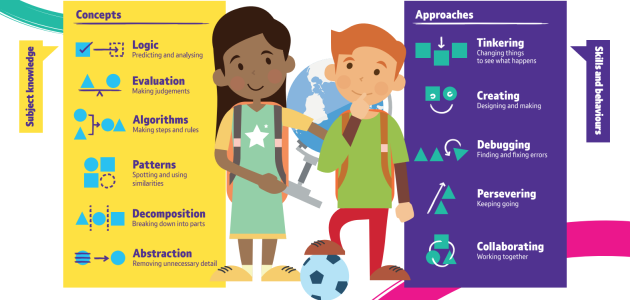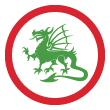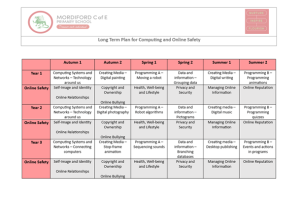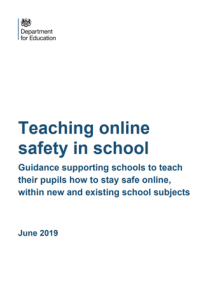Intent
Technology is becoming an everyday part of life. At Mordiford CE Primary School, we hope to prepare our children for a future in an environment which is shaped by technology. Therefore, we want to model and educate our children on how to use technology positively, responsibly and safely. We aim to encourage our pupils to be creators not consumers and our curriculum encompassing computer science, information technology and digital literacy reflects this. We want our pupils to understand that with technology comes choices, as a school we want to model and support these positive choices and highlight the risks that may possibly come by making incorrect ones.
We encourage staff to try and embed computing across the whole curriculum to make learning creative and accessible for all children. We want children to become fluent with a range of tools to best express their understanding. We want children to feel comfortable and confident with using and exploring these tools independently by the time they reach Upper Key Stage 2.
National Curriculum and DfE Documents
Implementation
The computing curriculum at Mordiford CE Primary aims to equip children with the knowledge, skills and understand they need to thrive in the digital world they will be a part of both today and in the future. The curriculum can be broken down into three strands:
- computer science
- information technology
- digital literacy.
NCCE – Computer Science and Information Technology
At Mordiford CE Primary School, our scheme of work for computing is the ‘Teach Computing’ Curriculum and covers all aspects of the National Curriculum. This scheme was chosen as it has been created by subject experts and based on the latest pedagogical research. It provides an innovative progression framework where computing content (concepts, knowledge, skills and objectives) has been organised into interconnected networks called learning graphs.
Why we use NCCE Teach Computing Curriculum? To embed an inclusive, enriched computing curriculum with clear progression across the school.
- Resources include clear a overview, scaffolding, exploratory tasks, clear progression and both formative and summative assessments
- Each key stage has a clear curriculum map
- Built around an innovative progression framework where computing content has been organised into interconnected networks we call learning graphs
- Created by subject experts, using the latest pedagogical research
- All of the content is free to use, and in formats that make it easy for us to adapt and expand and meet the needs of our pupils.
- The 6 strands allow the children to enjoy many elements of the computing curriculum and not just coding. Creative Media allows children to work on their creative skills whilst Computer Systems and Networks allow the children to understand computer networks including the Internet and how they can provide multiple services such as the World Wide Web.
Project Evolve – Digital Literacy and Online Safety
A key part of the computing curriculum is ensuring that children are accessing technology safely and responsibly. Children have a right to enjoy childhood online, to access safe online spaces and to benefit from all the opportunities that a connected world can bring them, appropriate to their age and stage.
Children develop this awareness and responsibility through the use of the ‘Project Evolve – Education for a Connected World’ framework. The framework aims to support and broaden the provision of online safety education, so that it is empowering, builds confidence and creates a positive online environment.
Computing is taught every week as a stand-alone lesson or embedded into the wider curriculum. This is dependent on the area of focus for that specific half term.
Children have access to a range of hardware: computers, laptops, tablets, programmable equipment (crumbles, BeeBots, dataloggers) and software that they need to develop knowledge and skills of digit systems and the applications.
Elements of online safety are also covered within our Teach Computing curriculum and our PSHE lessons. In addition, the whole school has an online safety focus for one day, when each class completes online safety tasks (including Safer Internet Day). We also take part in AntiBullying Week, during which online bullying is addressed. Parents are informed when issues relating to online safety arise and further information/support is provided if required.
Expectations of Computing
Key stage 1 Pupils should be taught to:
- understand what algorithms are; how they are implemented as programs on digital devices; and that programs execute by following precise and unambiguous instructions
- create and debug simple programs
- use logical reasoning to predict the behaviour of simple programs
- use technology purposefully to create, organise, store, manipulate and retrieve digital content
- recognise common uses of information technology beyond school
- use technology safely and respectfully, keeping personal information private; identify where to go for help and support when they have concerns about content or contact on the internet or other online technologies.
Key stage 2 Pupils should be taught to:
- design, write and debug programs that accomplish specific goals, including controlling or simulating physical systems; solve problems by decomposing them into smaller parts
- use sequence, selection, and repetition in programs; work with variables and various forms of input and output
- use logical reasoning to explain how some simple algorithms work and to detect and correct errors in algorithms and programs
- understand computer networks including the internet; how they can provide multiple services, such as the world wide web; and the opportunities they offer for communication and collaboration
- use search technologies effectively, appreciate how results are selected and ranked, and be discerning in evaluating digital content
- select, use and combine a variety of software (including internet services) on a range of digital devices to design and create a range of programs, systems and content that accomplish given goals, including collecting, analysing, evaluating and presenting data and information
- use technology safely, respectfully and responsibly; recognise acceptable/unacceptable behaviour; identify a range of ways to report concerns about content and contact.
Impact
How we know our curriculum is effective
The success of our Computing curriculum is assessed by both teachers and the Computing Lead in order to inform future adaptations of the schemes of work and help to ensure that progression is evident throughout school.
The Computing lead will:
- Conduct pupil voice sessions, ensuring children are actively contributing to our curriculum content
- Carry out staff audits to monitor staff confidence and satisfaction with our Computing curriculum
- Monitor work on digital platforms and within the class Computing book against each year groups’ long-term plan and review annual progress data (recorded on our Insight tracker)
We aim that our pupils should:
- Be enthusiastic and confident in their approach towards Computing
- Present as competent and adaptable ‘Computational Thinkers’ who are able to use identified concepts and approaches in all of their learning
- Be able to identify the source of problems and work with perseverance to ‘debug’ them.
- Create and evaluate their own project work
- Have a secure understanding of the positive applications and specific risks (and benefits) associated with a broad range of digital technology
- Transition to secondary school with a keen interest in the continued learning of this subject
What is Computational Thinking?





